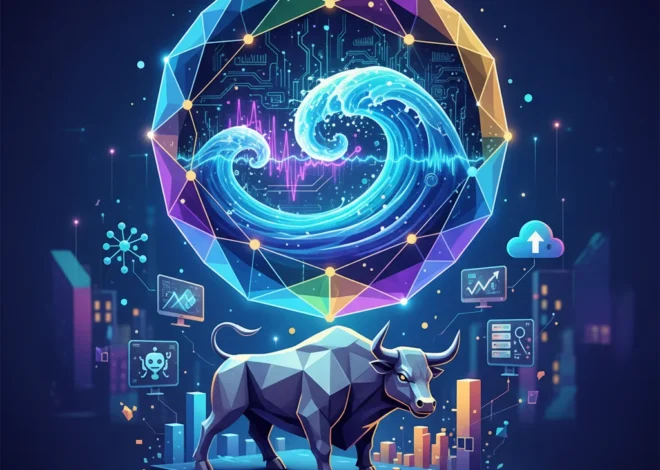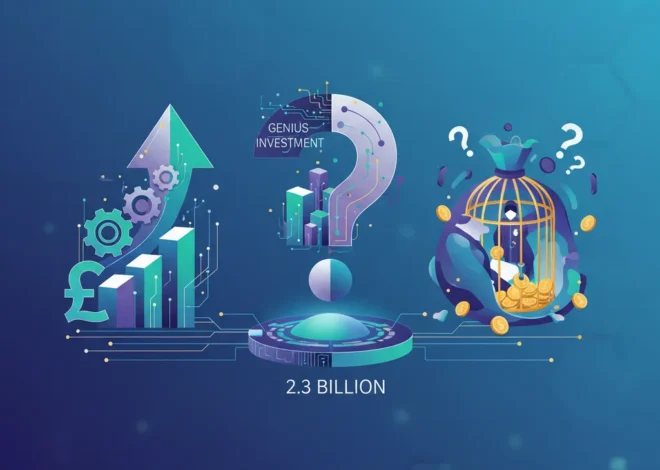
The Trillion-Dollar AI Question: Are We in a Bubble or a Revolution?
Let’s talk about a number so big it almost loses meaning: one trillion dollars. That’s not the GDP of a small country; it’s the approximate value gained by just 10 artificial intelligence groups—including giants like OpenAI and Elon Musk’s xAI—in the last year alone. The investor frenzy is palpable. Money is pouring into AI startups at a rate that makes the dot-com boom look quaint.
The headlines are screaming, the valuations are soaring, and everyone from seasoned venture capitalists to your tech-savvy cousin is talking about it. This has led many to ask the trillion-dollar question: Is this a classic, unsustainable bubble destined to pop, or are we witnessing the foundational moments of a technological revolution on par with the internet itself? The truth, as is often the case, is likely somewhere in the middle. Let’s peel back the layers of hype, capital, and code to understand what’s really going on in the world of artificial intelligence.
The Jaw-Dropping Numbers Behind the AI Gold Rush
To say the growth has been explosive is an understatement. We’re seeing funding rounds and valuations that would have been unthinkable just a few years ago. According to a recent analysis by the Financial Times, a select group of AI leaders has seen their collective worth skyrocket, driven by an “unprecedented” wave of funding. This isn’t just a gentle updraft; it’s a Category 5 hurricane of capital.
Let’s put this into perspective. The combined value of these top AI companies is now brushing against the trillion-dollar mark, a milestone achieved in a breathtakingly short period (source). Companies that were little more than a research paper and a team of brilliant minds are now being valued as mature, market-dominating enterprises.
Here’s a snapshot of some of the key players and the staggering valuations they command, illustrating the sheer scale of this investment boom:
| Company | Notable Investors / Partners | Reported Valuation / Funding | Key Focus Area |
|---|---|---|---|
| OpenAI | Microsoft | Valued at over $80 billion | Foundational Models (GPT series), AI Research |
| Anthropic | Google, Amazon | Raised $7.3 billion in the last year | AI Safety, Foundational Models (Claude series) |
| xAI | Elon Musk | Raised $6 billion at an $18 billion pre-money valuation | “Truth-seeking” AI, Foundational Models (Grok) |
| Mistral AI | Microsoft, Andreessen Horowitz | Reportedly raising funds at a $5 billion valuation | Open-source AI models, European AI leadership |
| Inflection AI | Microsoft, Reid Hoffman, Bill Gates | Raised $1.3 billion | Personal, empathetic AI (Pi) |
These figures aren’t just numbers on a spreadsheet; they represent a massive bet on the future. Investors are not paying for current revenue or profits. They are paying for the perceived potential of these companies to redefine entire industries, from software development and cybersecurity to healthcare and entertainment. The question is whether that potential can ever justify the price tag.
Banned by a Bot: When AI Gets It Wrong on Social Media
What’s Fueling This Unprecedented Frenzy?
So, why is this happening now? Several powerful forces are converging to create this perfect storm of AI investment.
- The “ChatGPT Moment”: The public launch of ChatGPT in late 2022 was an inflection point. It wasn’t just a technological breakthrough; it was a marketing one. For the first time, millions of people could directly interact with a powerful large language model (LLM). This demystified AI, showcased its immense capabilities, and triggered a massive wave of FOMO (Fear Of Missing Out) across the entire tech and investment landscape.
- The Big Tech Arms Race: The AI boom is inextricably linked to the strategic goals of tech titans like Microsoft, Google, and Amazon. Their involvement is a double-edged sword. On one hand, they are the biggest investors, pouring billions into startups like OpenAI and Anthropic. On the other, they are the primary beneficiaries, as these AI companies require colossal amounts of computing power, which they purchase from the investors’ own cloud platforms (Azure, Google Cloud, AWS). This creates a symbiotic, and somewhat circular, flow of capital that inflates the entire ecosystem.
- A Paradigm Shift in Technology: Unlike some previous tech bubbles built on flimsy business models, the current AI boom is built on genuine, undeniable technological innovation. The advancements in machine learning, particularly in transformer architectures, have unlocked capabilities that were science fiction a decade ago. This isn’t just about faster websites; it’s about creating entirely new ways to work, create, and solve problems.
So, is it a bubble? One investor quoted in the FT article bluntly says, “Of course it’s a bubble.” And in a sense, he’s right. The valuations are almost certainly inflated by hype and speculative capital. A correction feels inevitable. But a bursting bubble doesn’t mean the underlying technology is worthless. The dot-com crash wiped out Pets.com, but it didn’t kill the internet. Amazon and Google survived and thrived. Similarly, a correction in the AI market will likely wash away the weaker players, but the foundational model companies and those with truly viable, defensible applications will emerge stronger, defining the next decade of technology. The real story isn’t the bubble; it’s what’s left after it pops.
The New Economics of AI: Compute, Talent, and Moats
Building an AI company today is fundamentally different from building a SaaS startup in the 2010s. The old playbook of “lean startup” methodology doesn’t quite apply when your primary raw material—computational power—costs millions of dollars a month.
The Insatiable Thirst for Compute
Training a state-of-the-art foundational model requires thousands of specialized GPUs (like Nvidia’s H100s) running for weeks or months on end. This is an astronomically expensive endeavor. This capital-intensive nature means that only the most well-funded startups can even compete at the foundational level. It creates a high barrier to entry and concentrates power in the hands of a few.
The War for Talent
The second critical resource is human capital. There is a finite number of researchers and engineers who can build, train, and fine-tune these complex models. This has ignited a fierce talent war, with top AI experts commanding salaries and equity packages that rival those of professional athletes. Expertise in specialized areas of programming, distributed systems, and machine learning algorithms is now one of the most valuable commodities in the world.
Where is the Defensible “Moat”?
For investors, the key question is long-term defensibility. If a new, better model can be built by a competitor with enough funding, what prevents a race to the bottom? Companies are trying to build “moats” in several ways:
- Proprietary Data: Access to unique, high-quality datasets for training can provide a significant edge.
- Distribution & Integration: Getting models deeply embedded into existing enterprise software and platforms (e.g., Microsoft Copilot) creates stickiness.
- Brand and Trust: As AI becomes more critical, businesses will gravitate towards trusted, reliable, and secure providers, making brand a key differentiator, especially concerning cybersecurity and data privacy.
All In: Why the U.S. Economy is Making a Trillion-Dollar Bet on AI
The Risks Looming on the Horizon
While the potential is immense, the path forward is fraught with risk. The higher the climb, the harder the fall, and the current altitude of the AI market is dizzying.
A significant market correction could freeze funding and leave many “application-layer” startups—those building on top of foundational models from OpenAI or Anthropic—stranded. These companies are often entirely dependent on the APIs and pricing structures of the model providers, giving them very little leverage.
Furthermore, the concentration of power is a real concern. A handful of companies, backed by a handful of tech giants, are building the foundational intelligence layer for the future. This raises important questions about competition, censorship, and algorithmic bias. The promise of AI is one of democratized intelligence, but its current trajectory seems to be leading towards a new kind of technological oligarchy.
Finally, there’s the simple economic reality. These models need to generate revenue that justifies their valuations. While enterprise adoption is growing, it’s still early days. The true return on investment for many businesses is yet to be proven. If that ROI doesn’t materialize at scale, the investor enthusiasm could cool as quickly as it ignited.
The AI Chip Wars Just Got Real: Is OpenAI About to Bet Billions on AMD?
Beyond the Bubble: The Enduring Revolution
It’s easy to get lost in the financial speculation, but it’s crucial to remember the technological reality. The innovation happening in artificial intelligence is real and transformative. We are witnessing a fundamental shift in how we interact with information and technology. This wave of automation is poised to create efficiencies and capabilities we can barely imagine today.
Whether you’re a developer learning new programming paradigms for AI, an entrepreneur spotting an opportunity for a new application, or a professional looking to leverage these tools in your work, the message is the same: pay attention. The market will have its ups and downs. Some companies will fail spectacularly. But the underlying technology is here to stay.
The current frenzy may be a bubble, but it’s a bubble forming around a core of solid gold. The challenge for all of us is to distinguish the speculative froth from the substantive, world-changing technology at its center. The next few years will be a wild ride, but one thing is certain: the world on the other side will look very different.


